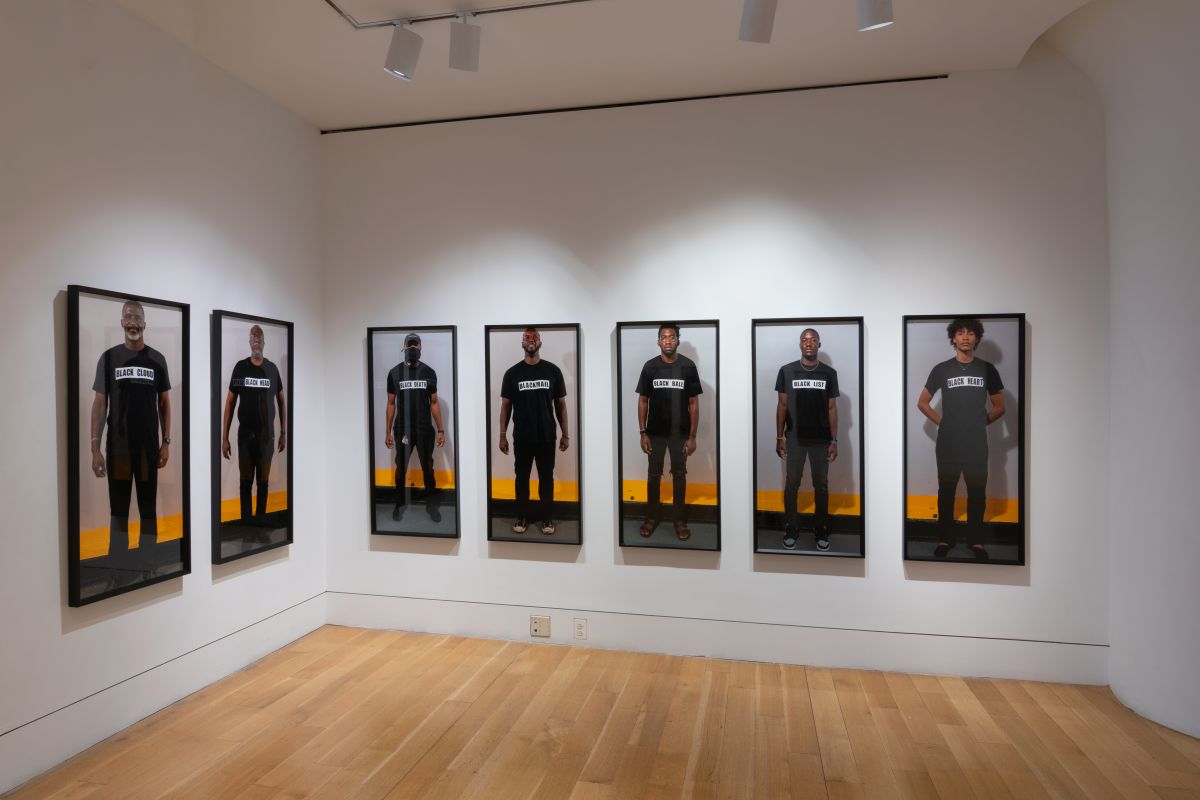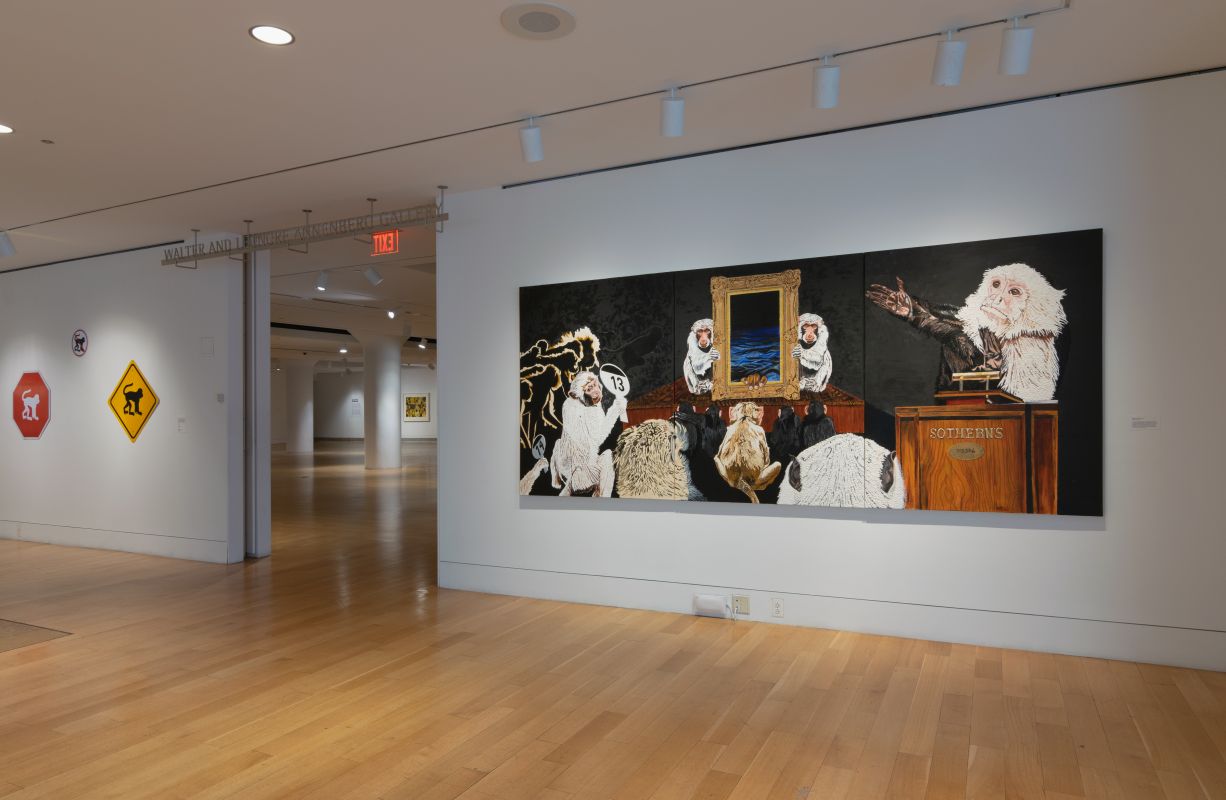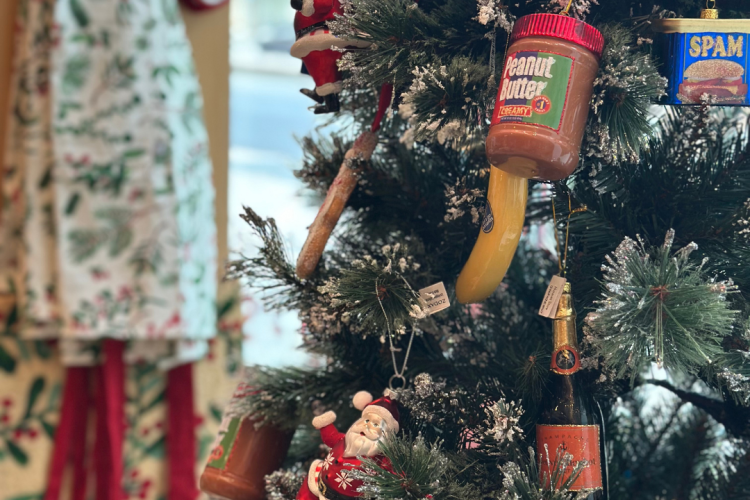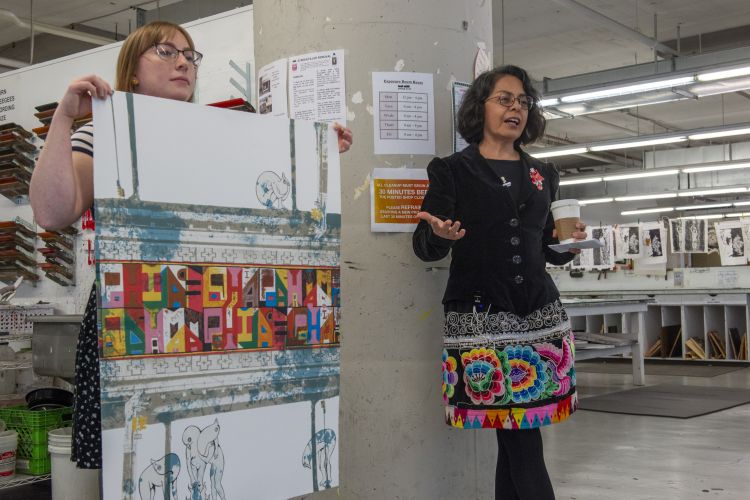STORIES FROM PAFA
Michael Coppage (MFA ’05) Confronts Centuries of Negativity with Resiliency in American+
American+, a touring solo exhibition by interdisciplinary artist Michael Coppage (MFA ’05), kicked off the new year in PAFA’s School of Fine Arts Gallery. A venue for alumni showcases, the 2710 square-foot gallery is the largest that American+ has been shown in so far, allowing Coppage to display more—though still not all—of his expansive, varied exhibit, much of which dates back as far as 2018. “It’s a really interesting reality and experience for me because I’ve never seen all of the paintings in the same room outside of my studio,” says the artist. After it closes in Philadelphia, the exhibition will move on to locations around the country for at least the next two years. He aims for the works to tour for five years.
One large element of the exhibit, Black Box, combines lens-based works featuring Black men paired with phrases that have instilled the word ‘black’ with a negative connotation and contributed to racial biases. Each image can be experienced with supporting audio and video interviews that reinforce the diversity between the thirteen men. “Even though they all identify the same, they couldn’t be more different from each other generationally, ethnically, culturally, educationally…” says the artist of his subjects. Black Box is a five-part project, and was previously installed as a mural in Cincinnati, where Coppage lives. An upcoming second iteration, featuring images of Black women, is set to be installed in Harlem in 2022.
American+ also includes a series of oil paintings with Black protagonists affected by different species of white monkeys as the antagonists. Each painting represents one specific facet of the Black male experience. The choice of the medium was a careful strategy by Coppage. He notes that for centuries, white people have been magnified in the western art tradition, especially painting, as affluent and esteemed, depicted as gods, saviors, and angels. Additionally, he has seen white audiences engage less with Afrocentric artwork if they assume it’s not for them. “They spend no time with the work. And I didn't want that,” he says. By choosing the medium of painting, he has implicitly centered whiteness for many viewers. “It’s a strategy I employ to encourage you and prompt you to spend more time with each of the works. And it's sad that I have to do that to make Black narratives important.”
Earlier this month, Coppage attended the reception for the exhibition at PAFA, somehow managing to fit the celebratory event into his packed schedule. (And packed it is. He conducted this interview in between tasks at the Kennedy Heights Arts Center, where he will hang a show with Juneteenth Cincinnati in a few days). Fellow alumni from his years at PAFA came out to the reception to support him, and he was able to meet face-to-face both new PAFA President Eric Pryor and the alumni coordinator, C.J. Stahl, who helped to bring his work to Philadelphia. It was also a chance for audiences to hear from the artist in a one-on-one setting, wherein his works served a dual purpose as an artistic product and an important conversation starter.
Coppage is conscious of his paintings as a tool or respite for people uncomfortable with talking about race, but also, and perhaps more importantly, as a “lifehack” for himself. His internal emotions can move to the external when he translates them to a painting. “I take all of that stuff and I crystallize it one bite-size morsel at a time in each work of art,” says Coppage. Thus, for his viewers, he creates a visual connection to what he has to say. “The equity so many corporations and institutions are talking about comes when you also help me carry some of this baggage from this Black trauma experience, because I didn't get here by myself,” he continues. “I think that there should be some responsibility of the viewer to carry some that. When I speak to school groups or I speak to folks at openings, I always say, ‘You're a collaborator now. Welcome to it and make sure you take your share of this experience and let’s try to eliminate this for someone else.’”
—Diana Wensley, content writer
American+ is on display through March 27, 2022. Learn more.
Keeping Up With Michael Coppage in 2022
Coppage’s upcoming projects this year include:
PACE Artist Catalyst Program with Louisville Visual Art, $30,000 award to produce socially engaged, participatory public art project
ArtsWaves 2022 Truth and Reconciliation $15,000 Grantee, supporting a special bronze sculpture project titled 12 Commandments
Curator of Voices of Freedom exhibition at Kennedy Heights Art Center, Cincinnati, February 26 to March 26, 2022
Harlem Art Crawl Residency on Governors Island, NY, June 2022
Truth and Reconciliation exhibition at the National Underground Railroad Freedom Center and Cincinnati Art Museum, July 22 to August 22, 2022
American+ solo exhibition in partnership with FOTOFOCUS at the Weston Gallery, Cincinnati, September 16 to November 16, 2022; this exhibition will be all lens-based works
60-foot installation that will be project-mapped and animated at Blink, the largest outdoor light-based art exhibit in the world, October 13 to 16, 2022 in Cincinnati

photographs, 4 channel video, and podcasts with 13 individuals
Black Box is a multimedia project designed to positively promote Black men, furthering understanding and empathy while fostering education and healing. Thirteen Black men were interviewed and photographed for this project. In the photographs each man wears a shirt with an assigned noun preceded by the word black. Nouns preceded by the word "black" carry an implied negative connotation, and what we learn during our American enculturation is black most often implies "bad." An accompanying video work shares the perspective of the participants, ages 19–92, without interruption, dismissal, contention, minimization, or comparison. Lastly, a thirteen-episode podcast houses complete interviews with each of the participants, which can be accessed by scanning a QR code at the exhibition.

Oil on canvas
Lot 13 is a three-part allegory about the parallel between the auctioning of Black labor, i.e. enslaved Blacks, and the auctioning of artworks made by Black artists. Each canvas highlights various stages of transaction, commenting on the long-term trauma that slavery has on Black people living today, and the circulation of artworks made by Black artists in contemporary America.
We're so excited you're planning to visit PAFA!
Make time for art — visit us Thursday to Sunday.
Before reserving your tickets, please review helpful information about museum hours, accessibility, building access, and special admission programs.
If you have any questions, feel free to reach out to us at visitorservices@pafa.org — we’d love to help!



